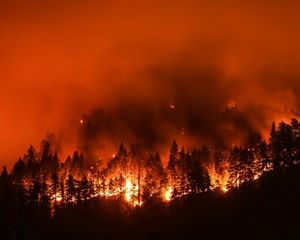Why Salmon Matter
Coho salmon play an integral role in the health of our Northern California coastal ecosystem and restoring populations of this endangered species has the potential to produce wide-ranging benefits for both people and nature. Coho salmon are born in streams, mature in the ocean, then return to their natal river where they mate and die. This lifecycle means that coho salmon act as a critical link between the marine, freshwater and terrestrial systems. In their deaths, coho bring rich ocean nutrients back to the landscape, fertilizing forests and nourishing countless species of fish and wildlife.
Starting from the Bottom
Unsustainable land management practices have led to the loss of vital salmon rearing habitat, causing an extreme decline in the coho salmon population throughout the state. The Ten Mile River sits on the southern edge of a vast, intact landscape that can provide refuge for plants and animals that need cool, wet places live in a rapidly changing climate. TNC has protected and preserved nearly all of the lower Ten Mile River (3,850 acres). This protected land plays a key role in restoring habitat for coho salmon as well as many other sensitive species that call Ten Mile home. These include northern spotted owls, red-legged frogs, Chinook salmon, steelhead trout and tidewater goby.
Restoring the River
In 2013, TNC brought together a team of fisheries scientists and technical experts to formulate a restoration plan for the lower Ten Mile to reconnect floodplains and enhance habitat for salmon. Floodplains are important winter rearing habitat for young salmon as they provide a calm refuge from the raging flows that can occur during winter storms. Additionally, these marshy, nutrient-rich floodplains offer superb feeding opportunities for young salmon who use them as all-you-can-eat buffets during the critical point in their lifecycle when they are trying to bulk up to prepare for life in the ocean. Unfortunately, human land use changes have simplified river channels and systematically disconnected the Ten Mile River from its historical floodplain habitat.
Restoration Projects
To restore this lost habitat, a total of twenty restoration sites were identified along the South Fork of the river, and eight projects have been brought to life so far. Two large seasonally wetted floodplains now sit in what was previously disconnected pastureland and have been shown not only to provide refuge to coho salmon and steelhead trout, but to serve as important wetland habitat for native chorus frogs and waterfowl like mergansers and heron.
These projects also included the construction of over a dozen engineered log jams, large structures inside the stream made out of redwood and Douglas-fir trees. Log jams are designed to replicate the large accumulations of fallen trees that would have naturally occurred in these forested watersheds under historical old-growth conditions. These structures provide incredibly high-quality habitat, helping to create slow water refuge in the winter and do double duty providing cover and protection from predators during summer when flows are lower.
On the Mainstem Ten Mile, thirteen additional sites were identified to reconnect floodplains and enhance instream habitat for salmon, and two of these sites were constructed as recently as 2021. What was once a long, simplified river reach is now filled with complex habitat. Large, engineered log jams provide shelter for young salmon while alcoves graded into surrounding fields provide flow refuge during storms.
What Comes Next
We are now studying these projects and measuring fish use, in order to learn what is working and what could be improved. We will use the results of these studies to improve future projects both in the Ten Mile and elsewhere along the coast.
Although great strides have been made, our work on the Ten Mile River is far from over. Additional projects are in the design phase now and will be built over the next few years. We recently received a large Transformational Habitat Restoration and Coastal Resilience grant from NOAA that will help expand our work on the North Coast to plan, design, and implement a portfolio of projects across the region, including in Navarro and Garcia Rivers. In the Ten Mile, this grant helps fund restoration assessments and designs over multiple miles of river, and construction of multiple large-scale habitat enhancements, increasing the pace of restoration throughout the lower watershed.


